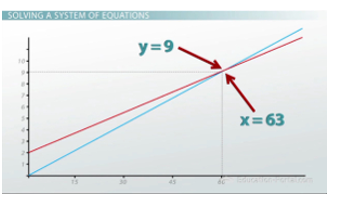Graph of a system of equations
Her equation begins down at zero because she doesn't get a head start. She starts down here at zero, but then every 1 mile she goes up, she only has to go over 7 minutes. So if we continue that pattern, we get a bunch of little points in a row; we connect all the points and we get a line for her as well.
And what we're looking for is where she catches me, which is where the lines intersect; the spot where they're in the same place. It appears to be right here. So it looks like she's going to beat me, but let's go ahead and check back with the algebra.
Setting Up a System of Equations
So because both of these equations are lines, that means they're linear equations, which means I can write them in slope-intercept form (mx+b). So the only two things I need for find for each equation is the slope (how much we're moving by) and the y-intercept (where we begin).
If we do my equation first, my beginning point is at 2 miles because I get a 2-mile head start. So my b value is 2. The slope, which is the rise over the run, is up 1 mile and over 9 minutes.
So my slope is 1/9, which means my equation is y = (1/9)x+2.
She, on the other hand, doesn't get a head start, so her y-intercept is zero. We could put a 'plus zero' on the end or we could just not write it at all. Her slope, how much she's moving by (the rise over the run), is she's going up 1 mile and over 7 minutes each time. Her slope is 1/7. Her equation is y = (1/7)x.

Solving for x in the system of equations
Solving a System of Equations
Since we're trying to find where these two equations are the same, we just want to know at what point are the ys and the xs the same. So if I want the ys to be the same - if I want my y to be the same as her y - what I can do is simply substitute what I know my yis in for her y. So where I see her y, I put what my yis. This means I take the expression (1/9)x+2 and put it where her y was. I get a new equation, which is (1/9)x+2 = (1/7)x. Now I have a linear equation with one variable that I can solve using inverse operations.
I can undo the (1/9)x with subtraction over to the other side. I have to do some fraction subtraction, so I have to do (1/7)x minus (1/9)x, which means getting a common denominator. (9/63)x minus (7/63)x gives me (2/63)x.
On the other side of the equation, we still have our 2. We now need to undo a fraction. I can undo a fraction by multiplying by its reciprocal. So I multiply both sides by 63/2. The x is now by itself and 2*63/2, using some fraction multiplication, tells us that x is equal to 63.
If we refer back to our graph, we see that the x-axis is minutes, and so we have just found that she is going to catch me in 63 minutes. But we're not exactly sure if that's before or after we've finished the 13 miles, so to find out where on the track that was, we have to substitute 63 back in to either equation. It actually doesn't matter which one because we're in the same spot, so we'll get the same answer either way.

Solving the system reveals the exact point where the runners meet up
I'll choose to plug it into hers because it's a little bit easier (we don't have to add the 2 on the end). And I get y = (1/7)*63. Doing another quick fraction multiplication problem, we end up with y = 9 miles. This means it took her 63 minutes to catch me and we were 9 miles into the race, so she totally beat me.
Lesson Summary
To review, a system of equations is any problem that has more than one equation in it. When we solve a system of equations, we're finding the point where those equations are the same. That means that if we graph the system, and we try to solve it using the graph, we find where the two lines intersect. The intersection point is our solution.
Whereas if we want to try solving it with algebra, we can use what's called the substitution method. If we know what one variable is, we can substitute the expression for one variable in for that same variable in the other equation and then solve the resulting equation.